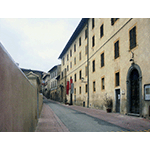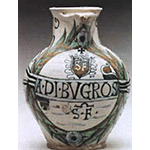Spezieria di Santa Fina [Santa Fina Pharmacy]
The "Spezieria" forms part, along with the Archaeological Museum and the "R. De Grada" Gallery of Modern and Contemporary Art, of the San Gimignano Civic Museums, housed in the former Santa Chiara Conservatory.
Its origin is very ancient, since it is directly connected to the Hospital of Santa Fina, founded immediately after the Saint's death (March 12, 1253) thanks to the offers of pilgrims and the intervention of the Commune, which promoted its construction and became its sponsor. The Hospital's property was rapidly incremented through donations that allowed the purchase of lands, houses and mills, and during the course of the 15th century it also incorporated other small hospitals. In 1584 it passed under the authority of the Bigallo Magistrature in Florence, remaining so until 1777. Then in 1816 it was united with the Hospital of Santa Maria della Scala in Siena.
Around 1505, two rooms in the Hospital were equipped as a pharmacy; over the course of time, especially between 1679 and 1685, they were extensively remodelled. The space available consisted of four rooms, and the pharmacy was opened to the public. The last enlargement, with seven rooms, dates from 1876, but a few years later the pharmacy was suppressed.
Among the records of the expenses incurred at the time of the great plague epidemics (1630-33) can be read curious accounts of the remedies prepared in the pharmacy and applied during the epidemic. Hundreds of pounds of honey were used as a lenitive and remedy for catarrh. A remarkable quantity of violets must have been used, not only as the ingredient of various medicines, but also to disinfect and perfume the closed areas of the Hospital. It was believed, in fact, that contagion was spread through bad air, and so there was an enormous number of recipes for making scent-balls, to be held to the nose as a "filter" for the air. And to keep the inhaled "poison" from mixing with the saliva, it was recommended to chew bitter roots that disinfected the oral cavity. Sudorific agents or purges were also prescribed to expel the "poison" by sweating or through evacuation.
Today the pharmacy's collection consists mainly of ceramic jars (from the second half of the 15th century to the 17th, coming from the manufactories of Montelupo Fiorentino) and glass receptacles (from the 17th to the 19th century) with medicinal preparations, in addition to various objects and furnishings. The exhibition occupies a small corridor and two rooms, in one of which the pharmacy with its nineteenth-century shelves and counter is reproduced, while the other contains a reconstruction of the laboratory.
****************************
Texts by Antonella Gozzoli
English translation by Catherine Frost
Last update 04/gen/2008





